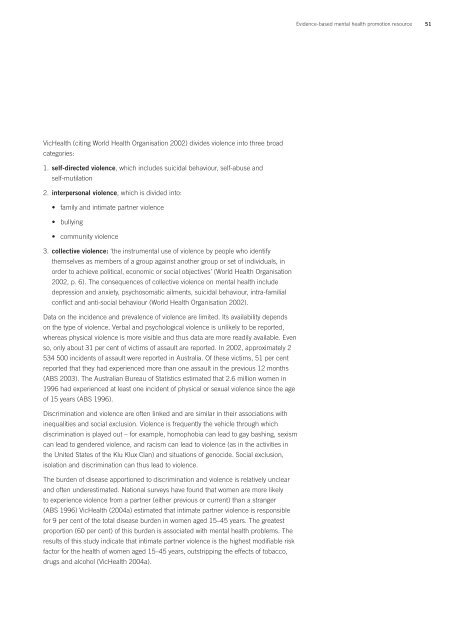Evidence-based mental health promotion resource - health.vic.gov.au
Evidence-based mental health promotion resource - health.vic.gov.au
Evidence-based mental health promotion resource - health.vic.gov.au
You also want an ePaper? Increase the reach of your titles
YUMPU automatically turns print PDFs into web optimized ePapers that Google loves.
<strong>Evidence</strong>-<strong>based</strong> <strong>mental</strong> <strong>health</strong> <strong>promotion</strong> <strong>resource</strong>51VicHealth (citing World Health Organisation 2002) divides violence into three broadcategories:1. self-directed violence, which includes suicidal behaviour, self-abuse andself-mutilation2. interpersonal violence, which is divided into:• family and intimate partner violence• bullying• community violence3. collective violence: ‘the instru<strong>mental</strong> use of violence by people who identifythemselves as members of a group against another group or set of individuals, inorder to achieve political, economic or social objectives’ (World Health Organisation2002, p. 6). The consequences of collective violence on <strong>mental</strong> <strong>health</strong> includedepression and anxiety, psychosomatic ailments, suicidal behaviour, intra-familialconflict and anti-social behaviour (World Health Organisation 2002).Data on the incidence and prevalence of violence are limited. Its availability dependson the type of violence. Verbal and psychological violence is unlikely to be reported,whereas physical violence is more visible and thus data are more readily available. Evenso, only about 31 per cent of <strong>vic</strong>tims of ass<strong>au</strong>lt are reported. In 2002, approximately 2534 500 incidents of ass<strong>au</strong>lt were reported in Australia. Of these <strong>vic</strong>tims, 51 per centreported that they had experienced more than one ass<strong>au</strong>lt in the previous 12 months(ABS 2003). The Australian Bure<strong>au</strong> of Statistics estimated that 2.6 million women in1996 had experienced at least one incident of physical or sexual violence since the ageof 15 years (ABS 1996).Discrimination and violence are often linked and are similar in their associations withinequalities and social exclusion. Violence is frequently the vehicle through whichdiscrimination is played out – for example, homophobia can lead to gay bashing, sexismcan lead to gendered violence, and racism can lead to violence (as in the activities inthe United States of the Klu Klux Clan) and situations of genocide. Social exclusion,isolation and discrimination can thus lead to violence.The burden of disease apportioned to discrimination and violence is relatively unclearand often underestimated. National surveys have found that women are more likelyto experience violence from a partner (either previous or current) than a stranger(ABS 1996) VicHealth (2004a) estimated that intimate partner violence is responsiblefor 9 per cent of the total disease burden in women aged 15–45 years. The greatestproportion (60 per cent) of this burden is associated with <strong>mental</strong> <strong>health</strong> problems. Theresults of this study indicate that intimate partner violence is the highest modifiable riskfactor for the <strong>health</strong> of women aged 15–45 years, outstripping the effects of tobacco,drugs and alcohol (VicHealth 2004a).



